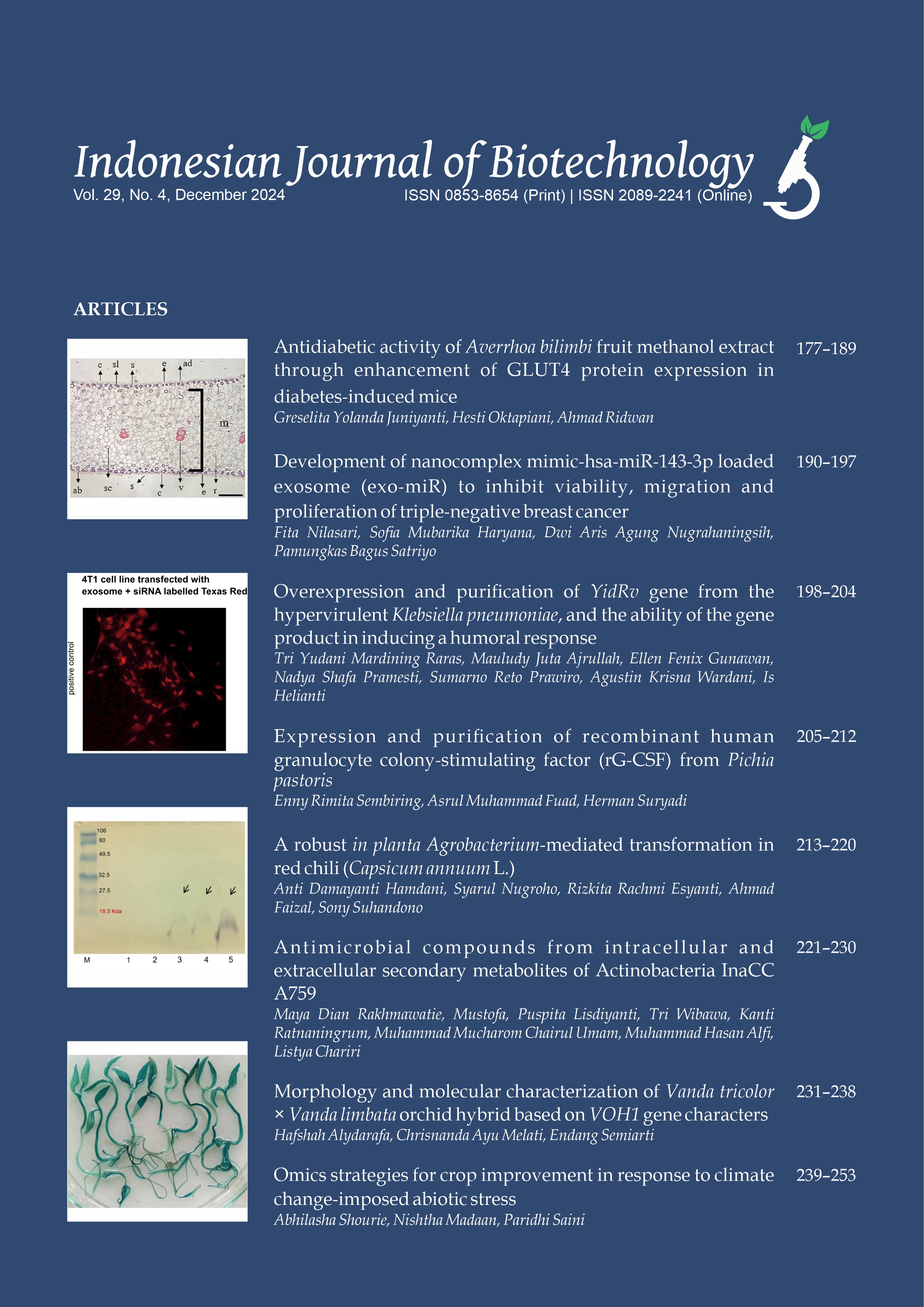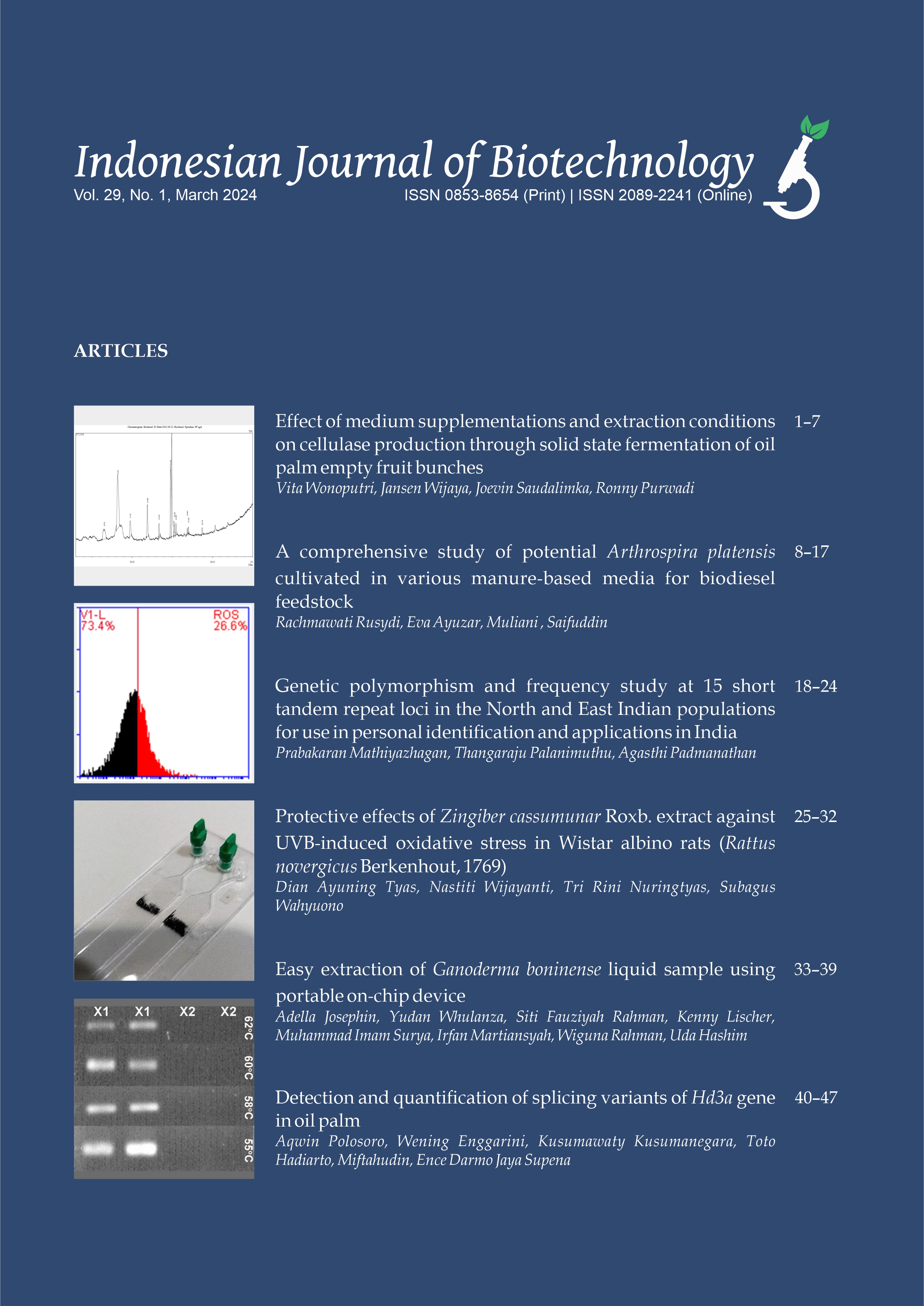Detection and quantification of pork and rat DNA in processed meats using multiplex quantitative Real‐Time PCR (m‐qPCR)
Nurul Azmah Nikmatullah(1), Etin Diah Permanasari(2*)
(1) Health Analyst Study Program, Faculty of Pharmacy, University of Muhammadiyah Prof. DR. HAMKA, East Jakarta, DKI Jakarta 13460, Indonesia; Center for Halal Studies, University of Muhammadiyah Prof. DR. HAMKA, East Jakarta, DKI Jakarta 13460, Indonesia
(2) Master of Pharmaceutical Science, Postgraduate School, University of Muhammadiyah Prof. DR. HAMKA, South Jakarta, DKI Jakarta 12740, Indonesia; Center for Halal Studies, University of Muhammadiyah Prof. DR. HAMKA, East Jakarta, DKI Jakarta 13460, Indonesia
(*) Corresponding Author
Abstract
In addition to the issue of pork contamination, processed meats frequently contain traces of rat meat. Therefore, detection and quantification of the pork and rat DNA in cases of meat and processed meat adulteration are necessary. In the current study, two gene targets of the cytochrome b for pigs and the Mt‐atp6 of Rattus norvegicus for rats were used in the absolute multiplex quantitative real‐time PCR (m‐qPCR). The sample DNA was amplified with a standard as positive control in the various concentration of 1000 pg, 100 pg, 10 pg, 0.1 pg, 0.01 pg, and 0.001 pg. There were 25 processed meat samples and 5 fresh meat samples identified in this study. Among the total of 30 samples assessed, 6 samples were successfully detected and quantified their pork and rat DNA contamination. One sample was contaminated with pork DNA with a concentration of 2.451×10‐4pg (“Meatball 3). Five samples were contaminated with rat DNA with a concentration of 3.603×10‐11pg (“Sempol 3”), 2.196×10‐10pg (“Meatball 6”), 4.908×10‐11pg (“Siomay 3”), 1.489×10‐10pg (“Grinding 2”), and 3.564×10‐10pg (“Grinding 4”). In this study, we have discovered that the contamination of pork and rat were detected in the samples. It suggested that this method is applicable for detecting the contaminant in processed meat samples
Keywords
Full Text:
PDFReferences
Adriany DT, Bakri AA, Bungalim MI. 2020. Comparison of DNA isolation methods on dna purity for detection of white spot syndrome virus (WSSV) on bamboo lobster (Panulirus versicolor). In: Pros. Simp. Nas. VII Kelaut. dan Perikan. 2020 Fak. Ilmu Kelaut. dan Perikan. Univ. Hasanuddin. p. 239–246.
Aini AN, Airin CM, Raharjo TJ. 2022. Protein markers related to nonhalal slaughtering process of rat as mammal animal’s model detected using mass spectrometry proteome analysis. Indones. J. Chem. 22(3):867–877. doi:10.22146/ijc.73656.
Andalia N, Adriani, Wardani AF, Sahli IT, Yunus R, Solfaine R, Nikmatullah NA, Meri, Rusdin A, Safitri NM. 2023. Molecular Biology. Padang: PT Global Eksekutif Teknologi.
Broeders S, Huber I, Grohmann L, Berben G, Taverniers I, Mazzara M, Roosens N, Morisset D. 2014. Guidelines for validation of qualitative realtime PCR methods. Trends Food Sci. Technol. 37(2):115–126. doi:10.1016/j.tifs.2014.03.008.
Cahyadi M, Fauziah NAD, Suwarto IT, Boonsupthip W. 2021. Detection of species substitution in raw, cooked, and processed meats utilizing multiplexPCR assay. Indones. J. Biotechnol. 26(3):128–132. doi:10.22146/ijbiotech.63472.
Cahyadi M, Wibowo T, Pramono A, Abdurrahman ZH. 2020. A novel multiplexPCR assay to detect three nonhalal meats contained in meatball using mitochondrial 12s rRNA gene. Food Sci Anim Resour. 40(4):628–635. doi:10.5851/kosfa.2020.e40.
Chisholm J, Conyers C, Booth C, Lawley W, Hird H. 2005. The detection of horse and donkey using realtime PCR. Meat Sci. 70(4):727–732. doi:10.1016/j.meatsci.2005.03.009.
Indriati M, Yuniarsih E. 2019. Multiplex PCR method of detecting pork to guarantee halal status in meat processed products. J. Ilmu Produksi dan Teknol. Has. Peternak. 7(3):96–101. doi:10.29244/jipthp.7.3.96 101.
Irwandi I, Wardi ES, Dova S. 2020. Detection of pig gene contamination in packaged beef meatball products in Padang using the PCR. Jurnal Akademi Farmasi Prayoga 5(2):1–12.
Kesmen Z, Gulluce A, Sahin F, Yetim H. 2009. Identification of meat species by TaqManbased realtime PCR assay. Meat Sci. 82(4):444–449. doi:10.1016/j.meatsci.2009.02.019.
Lestari D, Rohman A, Syofyan S, Yuliana ND, Abu Bakar NKB, Hamidi D. 2022. Analysis of beef meatballs with rat meat adulteration using Fourier Transform Infrared (FTIR) spectroscopy in combination with chemometrics. Int. J. Food Prop. 25(1):1446–1457. doi:10.1080/10942912.2022.2083637.
Liao J, Liu YF, Yang L, Li FP, Sheppard AM. 2017. Development of a rapid mitochondrial DNA extraction method for species identification in milk and milk products. J. Dairy Sci. 100(9):7035–7040. doi:10.3168/jds.201712653.
Luque-Perez E, Mazzara M, Weber TP, Foti N, Grazioli E, Munaro B, Pinski G, Bellocchi G, Van den Eede G, Savini C. 2013. Testing the robustness of validated methods for quantitative detection of GMOs across qPCR instruments. Food Anal. Methods 6(2):343– 360. doi:10.1007/s121610129445z.
Mariyani M, Sismindari SU, Rumiyati R. 2021. Validation of the realtime Polymerase Chain Reaction method for detecting pig (Sus scrofa domestica) and boar (Sus barbatus) DNA in beef sausages. Yogyakarta: Universitas Gadjah Mada.
Masnaini M, Achyar A, Chatri M, Putri DH, Ahda Y, Irdawati. 2023. Primer design and optimization of PCR methods for detecting mixed rat meat in food samples. In: Proc. 3rd Int. Conf. Biol. Sci. Educ. (IcoBioSE 2021). p. 282–289. doi:10.2991/978946463 1661_37.
Maulani TR, Susilo H, Indriati M, Suhaemi A. 2020. Detection of pig DNA contamination with RTPCR in sosis without halal labels from district Pandeglang. Gorontalo Agric. Technol. J. 3(2):72–80.
Mustaqimah DN, Septiani T, Roswiem AP. 2021. Detection of pork DNA in sausage using a Real TimePolymerase Chain Reaction (RTPCR). Indones. J. Halal 3(2):106–111.
Nida L, Pisestyani H, Basri C. 2020. Studi kasus: Pemalsuan daging sapi dengan daging babi hutan di Kota Bogor [Case study: Beef fraud with wild boar meat in Bogor City]. J. Kaji. Vet. 8(2):121–130. doi:10.35508/jkv.v8i2.2326.
Owolabi IO, Olayinka JA. 2021. Incidence of fraud and adulterations in ASEAN food/feed exports: A 20year analysis of RASFF’s notifications. PLoS One 16(11):e0259298. doi:10.1371/journal.pone.0259298.
Purwantoro R, Suryandani H, Hudaya DA, Yuniarsih E, Rostianti T. 2022. Detection of pork contamination in beef sausages using the multiplex PCR method in the Pandeglang district. Teknotika 01(2):1–6. URL https://ejournal.ftiunmabanten.ac.id/teknotika/a rticle/view/136/115.
Ramli MA, Salahudin A, Razak MIA, Idris MAH, Zulkepli MIS. 2018. Halal meat fraud and safety issues in Malaysian and Indonesian market. J. Halal Ind. Serv. 1(1):a0000008.
Salamah N, Erwanto Y, Martono S, Rohman A. 2019. RealTime PCRbased detection of bovine DNA by specific targeting on cytochromeB. Pharmaciana 9(2):201. doi:10.12928/pharmaciana.v9i2.14070.
Sari F. 2017. Identification of pig species in food products of animal origin in traditional markers of Riau Province using Polymerase Chain Reaction. Jurnal Riau Biologia 2(1):55–60.
Sihotang M, Sophian A, Purba M, Wilasti Y. 2023. Development of rat meat detection using Mtatp6 Rattus norvegicus gene genetic marker. Curr. Appl. Sci. Technol. 23(1):1–12. doi:10.55003/cast.2022.01.23.006.
Sihotang MAED, Erwinda YE, Suwarni E, Lusianti E. 2021. Desain primer dan analisis in silico untuk amplifikasi gen mtCo1 pada tikus got (Rattus norvegicus) [Primer design and in silico analysis for amplification of the mtCo1 gene in brown rats (Rattus norvegicus)]. Erud. Indones. J. Food Drug Saf. 1(2):20–29. doi:10.54384/eruditio.v1i2.82.
Siswara HN, Erwanto Y, Suryanto E. 2022. Study of meat species adulteration in Indonesian commercial beef meatballs related to halal law implementation. Front. Sustain. Food Syst. 6:882031. doi:10.3389/fsufs.2022.882031.
Sunaryo H, Nikmatullah NA, Mufidah S. 2022. Detection of rat contamination in sausage samples with real time PCR. Farmasains 9(2):57–64. doi:10.22236/farmasains.v9i2.7960.
Sunaryo H, Wirman AP, Permanasari ED, Nikmatullah NA, Lestari D, Nurjanah D. 2023. Optimization of DNA extraction methods in fresh meat (rat and chicken meat) based on incubation time. Indones. J. Halal Res. 5(2):99–108. doi:10.15575/ijhar.v5i2.21325.
Suryawan GY, Suardana IW, Wandia IN. 2020. Sensitivity of polymerase chain reaction in the detection of rat meat adulteration of beef meatballs in Indonesia. Vet. World 13(5):905–908. doi:10.14202/vetworld.2020.905908.
Susilowati T. 2019. Detection of pig DNA contaminants in meat grinding samples at market Surya of Surabaya using realtime PCR. Surabaya: Universitas Islam Negeri Sunan Ampel.
Tan LL, Ahmed SA, Ng SK, Citartan M, Raabe CA, Rozhdestvensky TS, Tang TH. 2020. Rapid detection of porcine DNA in processed food samples using a streamlined DNA extraction method combined with the SYBR Green realtime PCR assay. Food Chem. 309:125654. doi:10.1016/j.foodchem.2019.125654.
Tanabe S, Hase M, Yano T, Sato M, Fujimura T, Akiyama H. 2007a. A realtime quantitative PCR detection method for pork, chicken, beef, mutton, and horseflesh in foods. Biosci. Biotechnol. Biochem. 71(12):3131–3135. doi:10.1271/bbb.70683.
Tanabe S, Miyauchi E, Muneshige A, Mio K, Sato C, Sato M. 2007b. PCR method of detecting pork in foods for verifying allergen labeling and for identifying hidden pork ingredients in processed foods. Biosci. Biotechnol. Biochem. 71(7):1663– 1667. doi:10.1271/bbb.70075.
Waluyo S, Malau J, Raekiansyah M, Yulian E, Hardiman I. 2023. Deteksi dan kuantifikasi cemaran babi pada sampel olahan daging menggunakan realtime PCR [Detection and quantification of pig contamination in processed meat samples using realtime PCR]. AlKauniyah J. Biol. 16(1):46–52. doi:10.15408/kauniyah.v16i1.20203.
Widyasari YI, Sudjadi, Rohman A. 2015. Detection of rat meat adulteration in meat ball formulations employing real time PCR. Asian J. Anim. Sci. 9(6):460–465. doi:10.3923/ajas.2015.460.465.
Article Metrics
Refbacks
- There are currently no refbacks.
Copyright (c) 2024 The Author(s)

This work is licensed under a Creative Commons Attribution-ShareAlike 4.0 International License.









